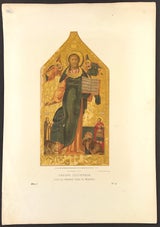Icon of the Saviour c1849
An extremely rare Russian Art Chromolithograph Print: Icon of the Savior. (Kept on the city wall in Smolensk. Chromolithography by F. Dreher. (Obraz Spasitelia. (Nakhod. Na gorodskoi stene, v Smolenske.) Ris. Akad. F. Solntsev. Khromolitografiia F. Dregera.)
Plate No 14 from Volume I. Watercolour by Acad. F. Solntsev. Chromolithography by F. Dreher.
Published in Antiquities of the Russian State - Drevnosti rossiiskago gosudarstva Moscow: A. Semen Press, 1849-1853 by Stroganov, Sergei Grigorevich & Solntsev, Fedor Grigorevich. Chromolithograph plates loose as issued. This was an elaborate description of a wide range of Russian artefacts conceived by A.N. Olenin, President of the Academy of Arts, and undertaken with the patronage of Czar Nicholas I. It was written by Stroganov and illustrated by Solntsev. The print run was a modest 600 copies.
Overall the Print is in good condition on heavy wove paper with some general age tone. There is some adhesive residue to the top left hand corner and creasing to the bottom left corner. The image remains good and vibrant. Plate size approx 14.5 x 20.25 (370mm x 515mm).
Czar Nicholas I, emperor of all Russia from 1825 to 1855, had his own image consultant, the artist Fedor Solntsev. Though he was apparently more a draftsman than a designer or ethnographer, Solntsev can be compared to Louis Comfort Tiffany and George Catlin. Not only did Nicholas commission Solntsev to design dinner services and decorate his private apartments in the Kremlin, he also engaged him to create illustrations for two encyclopedic books documenting Russian culture.
Nicholas commissioned him to make illustrations for what would become a six-volume tome titled “Antiquities of the Russian State.” The book started as a portable version of the vast riches housed in the Kremlin’s collection; it became a go-to manual on the Old Russian style, which reflected the country’s medieval past visually and also connoted the czar’s power over a huge and heterogeneous country.
The image campaign waged by Solntsev in the book portrays Russian rule as sanctioned by the Orthodox Christian faith from the Middle Ages onward.
An extremely rare print from a publication now over 170 years old.




